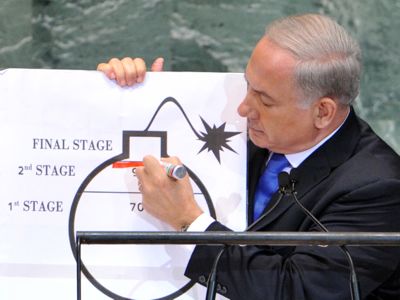Israeli Prime Minister wanted to impress public opinion by brandishing a naive drawing at the podium of the UN General Assembly, on 27 September, to accuse Iran of developing a nuclear bomb. But his approach backfired: he only succeeded in demonstrating the emptiness of his arguments and made it clear to everyone that he had much to hide.

We now know what the Iranian nuclear bomb will look like: a ball with a lit fuse, as portrayed in children’s comic strips. Israeli Prime Minister Netanyahu presented a drawing of it at the UN General Assembly and, just like a nursery school teacher, he pulled out a felt pen and drew a beautiful red line intersecting the bomb. Here, he said, is where the "the world’s most dangerous terrorist regime", the Iranian, must be stopped "before they get enough enriched uranium for the first bomb."
A completely different scenario should have been presented at the UN: that of the powerful Israeli nuclear arsenal, surrounded by the black line of secrecy and omertà. According to Jane’s Defense Weekly, Israel - the only nuclear power in the Middle East - has 100 to 300 nuclear warheads ready to launch ballistic missiles which, as in the case of the Jericho 3, can reach a range of 8 to 9 000 Km. Germany supplied Israel (as a donation or sold at bargain price) four modified Dolphin submarines: in addition to the original six torpedo tubes for launching short-range cruise missiles, each vessel has been equipped with four extra tubes for nuclear-armed Popeye Turbo cruise missiles with a range of 1500 km. Israel’s German-built submarines are extremely quiet and can remain submerged for over a week. They are currently cruising the eastern Mediterranean, the Red Sea and the Persian Gulf, ready around the clock for nuclear attack.
The United States, which has supplied Israel with more than 350 F-16 and F-15 fighter-bombers, has pledged to provide at least 75 dual-capable, nuclear and conventional, F-35 jets. The Pentagon, which withholds the access codes to F-35 software even from countries (such as Italy) involved in its construction, will nevertheless make them available to Israel so that it may integrate the F-35 in its own electronic warfare systems. The Pentagon will also give priority to the training of Israeli pilots, preparing them for nuclear attack with these fifth generation fighters.
Israel, which unlike Iran continues to refuse to join the nuclear non-proliferation treaty, will not admit that it possesses a nuclear arsenal (whose existence is recognized by the International Atomic Energy Agency) while suggesting threateningly that it has it and that it can make use of it. Accordingly, it also refuses to participate in the conference for the establishment of a nuclear-weapon-free zone in the Middle East, for which Iran has signed up.
Meanwhile, Israel, which according to SIPRI has produced, up to 2011, 690 to 950 kg of plutonium, continues to turn out sufficient quantities to produce each year from 10 to 15 bombs of a power equal to that of Nagasaki. It also certainly produces tritium, a radioactive gas with which it manufactures new-generation nuclear weapons. These include mini-nukes for deployment in a minor theater of war and neutron weapons which generate low radioactive contamination, but greater lethality due to their fast-neutron emission: the most appropriate for striking objectives at a close distance from Israel.
The Arab State members of the IAEA, who had prepared a resolution on "Israel’s nuclear capabilities" have, under U.S. pressure, agreed to delay its submission until 2013.
Meanwhile, the wick of the bomb - not the one on the drawing, but the real one in Israel’s possession - can be lit at any time.

 Articles by this author
Articles by this author Send a message
Send a message










Stay In Touch
Follow us on social networks
Subscribe to weekly newsletter